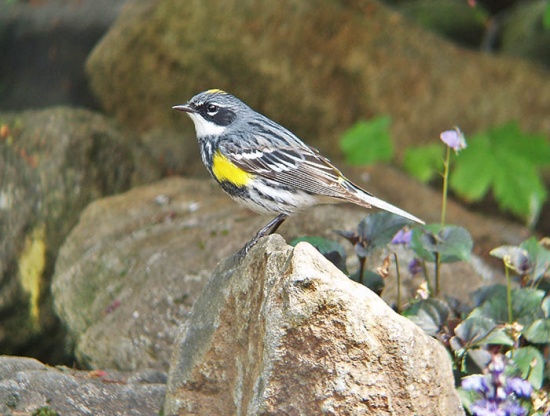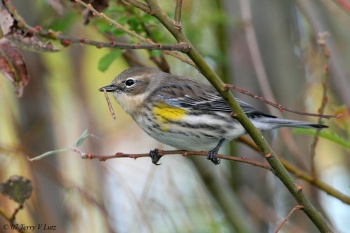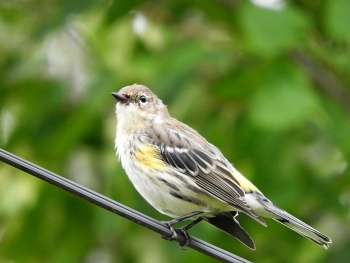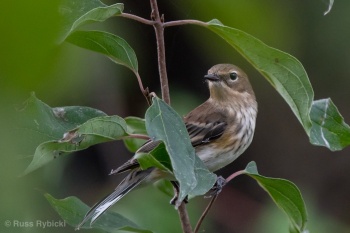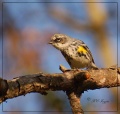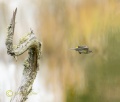- Setophaga coronata
Includes: Myrtle Warbler; Audubon's Warbler; West Mexico Warbler; Goldman's Warbler
Identification
14–15 cm (5½-6 in)
Yellow patches on rump and sides unique but those on the sides occasionally lacking.
Females are more brownish and in the Audubon's form may have whitish or buff throat.
Outside of breeding plumage, both sexes become duller but usually still show yellow rump and side patches.
Variations
Birds of subspecies nigrifrons (West Mexico Warbler) are large and have dark mantle, while Goldman's Warbler (goldmani) are large and have black mantle.
Breeding males of the Myrtle form and the form sometimes called Audubon's Warbler both have grey mantle with black stripes.
The Myrtle form has white throat and black on side of head mostly surrounded by white below the grey crown, while Audubon's have yellow throat, reduced white markings and less contrast between ear-coverts and crown.
Both forms have white wing bars but more extensive white feather edges in the Audubon's form. The Audubon's form become blacker in the southern parts of its range.
Distribution
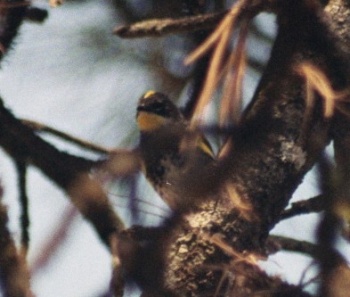
Photo © by Tom Jenner.
Cordillera de los Cuchumatanes in western Guatemala, 25 April 2006.
North America's most common warbler. Breeds from Alaska east to northern Quebec (absent only in arctic region) south across most of the western United States; northern Minnesota and Michigan; New York; western Pennsylvania, and New England; also along the Appalachians south to West Virginia.
Found anywhere in North America in migration. Winters in southern United States, along the west coast north to Washington, and in Central America. Rare in northern South America.
Casual vagrant to Great Britain (22 records).
Taxonomy
Formerly placed in genus Dendroica. The eastern (Myrtle) and western (Audubon's) races of this species were once considered separate species. Some authorities still do.
Subspecies
There are 4 subspecies2
- Group "Myrtle Warbler"
- S. c. coronata:
- Northern Alaska, Canada and northern USA; winters to Panama and West Indies
- Group "Audubon's Warbler"
- Group "West Mexico Warbler" (or sometimes called "Black-fronted Warbler")
- S. c. nigrifrons:
- Sierra Madre Occidental of western Mexico (Chihuahua to Durango)
- Group "Goldman's Warbler"
- Formerly subspecies S. c. memorabilis now lumped with auduboni;
- Former subspecies S. c. hooveri now lumped with coronata
Habitat
Coniferous and mixed forests also winters in open area.
Behaviour
Diet
Diet mostly insectivorous but will eat berries and other vegetation. Audubon's group eat some fruit in the winter months.
Breeding
Nest is a bulky cup of twigs, grasses and moss, lined with hair and feathers usually in a tree but sometimes on the ground. Clutch of 3–5 eggs, usually four. Nests fequently parasitized by Brown-headed Cowbird
Vocalisations
Song a variable and loosely structured rather slow, flat trill, often sounding two-parted and usually rising (but occasionally falling) at end.Usual call a sharp, emphatic “chup” or “chek”; flight call a soft, clear, high-pitched “sip” or “tsee”. Calls differ between subspecies groups.
Movements
This species is a largely "facultative migrant" responding to changing food supplies. Otherwise short-distance to long-distance migrant, and in autumn moves later than do most other parulids. Race S. c. goldmani.
Gallery
Click on photo for larger image
Moulting to Spring plumage, Myrtle Warbler
Photo © by KC Foggin
Myrtle Beach, South Carolina, 8 April 2016Winter plumage, Myrtle Warbler
Photo © by Robert Steffens
Huntington Beach State Park, South Carolina, 20 January 2015
Reference
- Dunn, Jon; Garrett, Kimball. 1997. A Field Guide to Warblers of North America. Boston: Houghton Mifflin Company. ISBN 9780395783214
- Clements, J. F., T. S. Schulenberg, M. J. Iliff, S. M. Billerman, T. A. Fredericks, B. L. Sullivan, and C. L. Wood. 2019. The eBird/Clements Checklist of Birds of the World: v2019. Downloaded from http://www.birds.cornell.edu/clementschecklist/download/
- Birdforum thread discussing the taxonomy of Yellow-rumped Warbler
- Hunt, P. D. and D. J. Flaspohler (2020). Yellow-rumped Warbler (Setophaga coronata), version 1.0. In Birds of the World (P. G. Rodewald, Editor). Cornell Lab of Ornithology, Ithaca, NY, USA. https://doi.org/10.2173/bow.yerwar.01
- Curson, J., Marks, J.S. & Kirwan, G.M. (2020). Myrtle Warbler (Setophaga coronata). In: del Hoyo, J., Elliott, A., Sargatal, J., Christie, D.A. & de Juana, E. (eds.). Handbook of the Birds of the World Alive. Lynx Edicions, Barcelona. (retrieved from https://www.hbw.com/node/61471 on 16 April 2020).
- del Hoyo, J., Collar, N., Marks, J.S. & Kirwan, G.M. (2020). Audubon's Warbler (Setophaga auduboni). In: del Hoyo, J., Elliott, A., Sargatal, J., Christie, D.A. & de Juana, E. (eds.). Handbook of the Birds of the World Alive. Lynx Edicions, Barcelona. (retrieved from https://www.hbw.com/node/1344159 on 16 April 2020).
Recommended Citation
- BirdForum Opus contributors. (2024) Yellow-rumped Warbler. In: BirdForum, the forum for wild birds and birding. Retrieved 9 November 2024 from https://www.birdforum.net/opus/Yellow-rumped_Warbler
External Links
GSearch checked for 2020 platform.1




